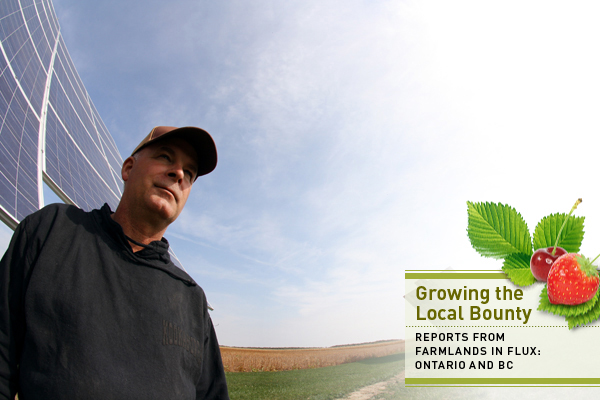Dave Ferguson, like all farmers, spends a good deal of time watching the weather. Today he's keeping an eye on the clouds that have been forming all afternoon. The air is heavy, humid, and you can almost taste the rain.
This time of year, early fall, is when the weather matters most. Ferguson is a cash cropper in southwestern Ontario, about an hour from London. Like most farmers here he grows soy, corn and wheat, and he needs to harvest while the sun shines. Timing is everything in this line of business, and two main forces will determine the difference between a good year and a bad year: the weather and the global markets. That's true for any farmer, but especially for those like Ferguson who depend entirely on these three food commodities.
Well, almost entirely. This year, Ferguson started harvesting solar energy on his farm, thanks to a new program in Ontario, MicroFIT, that offers a premium for energy generated from renewable sources like wind and solar.
"We are in food production, but now I'm in energy production with a minimal use of land," says Ferguson, standing in front of his two solar arrays, which sit in a tall grassy patch of land near the property line of his 100-acre farm. "This is helping me with some security for later on down the road."
Since the MicroFIT program launched last year, even supporters have been quick to point out that it has had its fair share of problems. But it proved that, with government support, farmers will eagerly invest hundreds of thousands of dollars in renewable technology -- the kind of small-scale, distributed and diverse renewable technology that many experts say we need to invest in right now. Farmers in B.C. say it offers the kind of incentive that we need here to help both struggling farmers and a nascent green tech sector.
In 2009, Premier Dalton McGuinty's Liberals introduced the Green Energy Act in Ontario. One of the things it did was expand the feed-in tariff (FIT) program, whereby the provincial arms-length utility, the Ontario Power Authority (OPA), would pay more for energy produce using renewable resources like wind or solar. The Ontario Federation of Agriculture welcomed the act, calling it an opportunity for farmers to take part in the "green energy revolution" and help create new manufacturing opportunities. "OFA will work with the government to ensure necessary safeguards accompany green energy developments to preserve farmland and protect the interests of rural residents," stated OFA president Bette Jean Crews in a press release.
The MicroFIT program is part of that, but it targets small projects, 10 kilowatts or less, that are installed and owned by individual homeowners or businesses. In return, those businesses and homeowners were guaranteed a hook-up to the grid, and a 20-year contract selling energy to the province at 80.2 cents per kilowatt hour.
The government offered no limits, promising that the program would be open until 2011, and that anyone who met the conditions would be offered a contract. The Ontario Power Authority was immediately swamped with interested parties. Within six months of launching, the program had received 16,000 applications.
"This is a one-shot deal, the MicroFIT system," says Ferguson. "The 80 cent a kilowatt hour [rate] was too rich -- it was a mistake by the OPA. But farmers can do math. We figured it out. This is a 10-year payback before I make money, then I have 10 years of making money. If you go to industry, they won't look at a 10-year payback. Farmers will."
In July of this year, when the Ontario government did in fact lower the rate offered under the MicroFIT program, there was a vocal backlash led in part by the Ontario Federation of Agriculture (OFA). It was successful in reversing the government's original decision to have the new rate retroactively apply to those who already had a conditional contract, and had invested in solar equipment.
The OFA has been able to play a role in shaping the MicroFIT program in other ways: for example, by ensuring that the program prohibits energy generation on Class 1 or 2 farm land. Don McCabe, OFA vice president currently sits on a panel that is reviewing the program.
He says so far, their main concern is ensuring that farmers who have accepted a conditional contract are able to hook their project into the grid in a timely manner. "We do have concerns about ensuring that the connections of these things are dealt with an in an appropriate manner to make sure we end up with a system that still has strong integrity in the long run," says McCabe, adding that generally, farmers seem to be pretty happy with how it's working so far. "The best feedback is no feedback."
The biggest benefit of the program is that it’s helped farmers diversify their income, says McCabe.
Ferguson agrees, and says it's been a financial boon not just for him but for the community as well. When the program was announced, Ferguson worked with nine other farmers in the area to collectively examine their options. They invited different solar and IT companies to give presentations, and were able to ask questions, ask for various features, and negotiate a price.
"This cost me a touch over $90,000,” says Ferguson. "If I went out and bought a new 100 horsepower, name-brand tractor, front wheel assist, fairly loaded up, I'd be looking at the same kind of money. And a tractor I use a few hundred hours a week. These are working every day, seven days a week."
Because the solar panels are hooked to the larger grid, it's not energy being used directly on Ferguson's farm. So it's not helping the farm per se, he says. But it does help the farm's bottom line, and it's a secure source of income at a time when prices for global food commodities like soy, corn and wheat are volatile.
"Is it too rich, yes, maybe it shouldn't have been this price," he says. "But it made us jump and the money I make will be spent here in Ontario."
Certainly, the MicroFIT program is not without its detractors. One energy analyst told the Toronto Star recently it has turned out to be an "unspeakable disaster." A large part of the criticism is due to the fact that, even though the feed-in tariff has been reduced from 80.2 to 64.2 cents per kilowatt hour for any new producers under the program, it's still costing the government -- and ratepayers -- a lot of money. The same electricity that OPA buys for 64.2 cents per kilowatt hour is sold wholesale to smaller utilities for between four and six cents per kilowatt hour. Electricity prices in Ontario have increased 18 per cent this year.
Still, renewable energy advocates like the B.C. Sustainable Energy Association and independent analyst Paul Gipe have said that a feed-in tariff is a key policy mechanism for strategically building renewable energy capacity so that it benefits rural and urban communities.
Because of B.C.'s hydro advantage, renewable energy in this province's agricultural sector has mainly been focused on biogas.
Chilliwack farmer Chris Bush recently began converting cow manure and farm waste into bio-methane, and Bill Vanderkooi, a dairy farmer in Abbotsford, is in the process of turning his farm, the Bakersview Eco-Dairy, into a commercial demonstration project for on-farm renewable energy. By the end of the month he expects to be finished the installation of an anaerobic digester that captures biogas from cow manure. That biogas will then be burned in a co-generator, to produce heat for the farm's learning centre and hot water tanks. Vanderkooi expects it will produce enough electricity to meet about 30 per cent of the farm's requirements.
Vanderkooi paid for the $500,000 digester with help from the BC Bioenergy Network, BC Hydro and the provincial Environmental Farm Plan program.
Although his farm only has 50 cows, "the purpose of what we're doing is to prove out this technology," says Vanderkooi. "We modeled it for a commercial-scale farm, somewhere between 150 and 200 cows."
Aside from energy production, anaerobic digestion technology can pull nutrients like nitrogen and phosphorus out of the manure. In the Fraser Valley, which is already over-burdened by these nutrients, Vanderkooi says this is perhaps the more exciting aspect of anaerobic digestion.
But he says that, compared to Ontario, B.C. is still at a disadvantage when it comes to on-farm renewable energy. "There is a proposal put forward to the ministry for a green energy rate that includes anaerobic digestion," he says. "But the policies aren't really in place here in B.C. the way they are in Ontario where they've been quite active over the past three years."
Once the farm is in a stronger financial position, Vanderkooi says they want to get small wind and solar going.
"It's a matter of finding the right partner and the right technology," he says. "But a rate premium is really quite important to provide the incentive for these." ![]()
Read more: Energy, Local Economy, Environment


















Tyee Commenting Guidelines
Comments that violate guidelines risk being deleted, and violations may result in a temporary or permanent user ban. Maintain the spirit of good conversation to stay in the discussion.
*Please note The Tyee is not a forum for spreading misinformation about COVID-19, denying its existence or minimizing its risk to public health.
Do:
Do not: